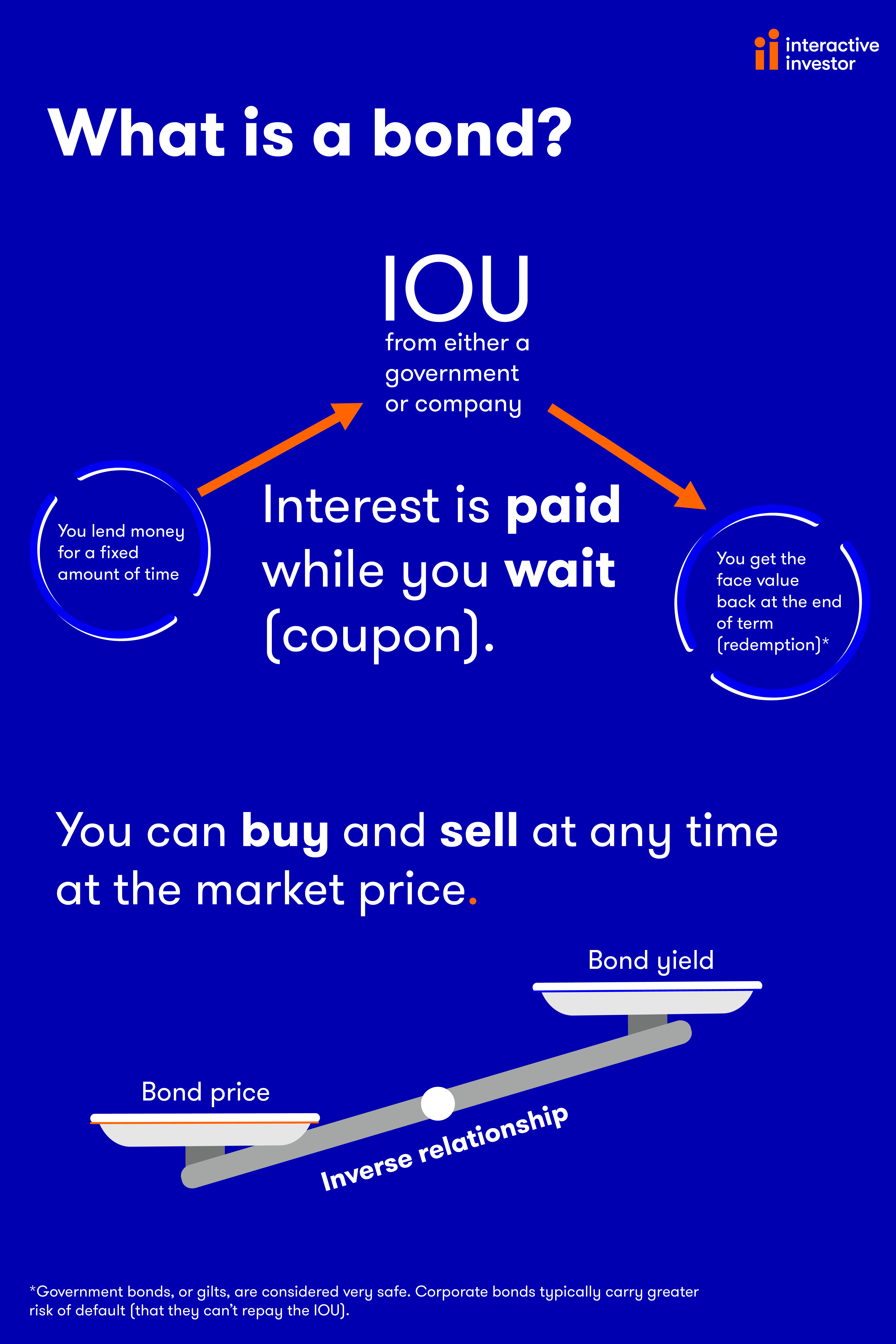The bond funds the pros are buying to snap up high income
11th August 2022 10:47
by Kyle Caldwell from interactive investor
Multi-asset fund managers have been increasing exposure to bonds for the first time in years. Kyle Caldwell explains why, and highlights the funds they have been buying.

It has been a dismal year so far for bonds, with soaring inflation and higher interest rates causing prices to plummet.
There could be further pain to come; moves to raise interest rates to cool inflation may not be successful, which could lead to the nightmare scenario of stagflation. This backdrop would be bad news for both bonds and equities.
- Learn about: How Bonds & Gilts work | Buy Bonds | Opening a Stocks & Shares ISA
Even if central banks fulfil their aim, the rates rises – if they prove to be too aggressive – could tip the economy into recession. In previous recessions, the lowest-risk bonds (government and investment grade) have been a defensive ballast that’s softened the impact of stock market falls. However, given that both bonds and stock markets have fallen in tandem this year, there’s question marks over whether bonds will offer the same level of protection as in the past.
The silver lining from the bond sell-off
While those risks remain, the silver lining of the bond market sell-off is that investors can now pick up the highest level of income on offer in a long time. Bond prices and bond yields have an inverse relationship, so falling prices mean yields have been rising – offering investors higher income today.
Vincent Ropers, portfolio manager of the TB Wise Multi-Asset Growth fund, is one investor who has been moving to take advantage. He thinks the downside risk for bonds is now limited, given the heavy sell-off that’s taken place so far in 2022.
Ropers says: “We believe pockets of fixed income look increasingly attractive. Although high inflation and rising interest rates are generally strong hurdles for the fixed income market, a good degree of downside already being priced in means yields now offer a greater degree of protection, at around the 3% level in US 10-year government bonds, 2% in the UK, and 1% in Europe.”
He argues that with the recession risk now looming large, bonds will resume their role as acting as a diversifier to equities. He recently purchased Vontobel TwentyFour Strategic Income, which has a yield of 6.2%.

Strategic bond funds have flexibility to protect and profit
Funds in the strategic bond sector can mix and match any type of bond, such as government bonds, investment-grade corporate bonds and high-yield bonds. In theory, the bond pros running these funds can steer their portfolios to the best bonds to profit from the macroeconomic backdrop. Funds in this sector also have the ability to select the best bonds to protect and profit from interest rate rises.
Other bond funds are more constrained in that they can invest only in a specific part of the bond market.
In interactive investor’s Super 60 list of rated funds, flexible bond options include the M&G Global Macro Bond and Jupiter Strategic Bond.
- Watch the other part of this video interview with Ariel Bezalel: why interest rates will fall in 2023 and how we are profiting
- Watch the other part of this video interview with Ariel Bezalel: an 8% bond yield and the ‘biggest opportunity’ for years
Anthony Willis, investment manager in the multi-manager people team at Columbia Threadneedle Investments, agrees that bonds now look good value. He said: “We are now getting paid a little bit more for the risks taken in bonds. In some places, the risk/reward has become a lot more attractive, so we are starting to become a lot more interested in selected bond funds.”
A recent purchase in Columbia Threadneedle Investments’ Lifestyle fund range is Artemis Short Dated Global High Yield. It invests in high-yield bonds that are close to maturity. Its yield is 8.6%.
Bonds with a short lifespan – a couple of years, for example – are less impacted by increases in interest rates compared to bonds with longer maturities.
The most important metric to look at is “duration”, which will be shown on a bond fund factsheet. Duration measures the sensitivity of individual bonds to changes in interest rates.
- Have claims to the death of the 60/40 portfolio been greatly exaggerated?
- Reasons why the bear market is far from over
- Why these defensive investments will continue to deliver
For every 1% rise in interest rates, a bond’s price will fall by about 1% for every year of “duration”. The longer a bond’s duration, the higher the yield an investor would expect in order to compensate for the greater risk involved.
Bonds priced in inflation ahead of equities
Chris Rush, an investment manager at IBOSS,has also been increasing exposure to bonds.
Rush says: “We believe that bond markers began pricing in the changing market conditions much sooner than equities. What we mean by this is that the price of fixed income assets changed to reflect increasing inflation concerns as the data reflected this reality.
“A situation that did not occur in equities, as stock markets hung doggedly to the idea that inflation was likely to be transitory until chair of the Federal Reserve Jerome Powell capitulated under the weight of inflationary data at the end of last November.”
At this juncture, Rush argues: “We may be approaching a situation where bonds not only provide diversification but could also provide some healthy returns for investors. Although as ever, this timing is likely to be incredibly difficult.”
Rush has been targeting bond fund teams that have in past proven to be flexible at adapting their exposure when economic conditions change. He highlighted Janus Henderson Strategic Bond and TwentyFour Corporate Bond as two funds he favours.
Not everyone is a bond bull
However, not everyone is finding value in bonds. David Hambidge, an investment director of multi-manager funds at Premier Miton Investors, points out that while yields have been rising they “look poor” against a backdrop of persistently high inflation, which he thinks is showing little sign of abating.
He points out that the credit spreads – the difference in yield between safe and riskier bonds of a similar lifespan – has become bigger following the sell-off.
“It has been a particularly tough time for credit (bond markets) of late with spreads having widened on concerns of a global economic slowdown and technical headwinds. Our portfolios remain relatively short in terms of duration, and are invested in a combination of open-ended and closed-ended funds.”
Hambidge has, though, bought one recent new position - Fidelity Emerging Market Total Return Debt fund, yielding 5%. The purchase was made “following a period of extreme weakness”.
- Why bonds are at a major turning point, according to veteran investors
- Bonds are back as a diversifier, despite rate rises
- Why bonds are back after a record-breaking sell-off
James Sullivan, head of partnerships at Tyndall Investment Management, is also not getting carried away. While acknowledging that bonds are much better value than six or nine months ago, Sullivan points out that the trade-off between bonds with a short and longer lifespan does not make the latter a bargain.
Sullivan said: “On the short end (three-month duration), I’m getting a yield of around 1% versus 1.7% to 2% for 10-year duration. Given that for every 1% interest rate rise the 10-year bond’s price will fall by 10%, the risk/reward dynamics are not great.”
His view is that inflation has peaked and will cool, and that in a year’s time bond yields will look more attractive in real terms.
In the event of a recession playing out, he says “there will be money to be made” given that bond prices would likely rise, and yields would fall, particularly if interest rates are cut.
Sullivan also expects bonds’ defensive qualities to shine through again following this year’s sell-off.
“The recovery in bond yields will led to a more normal correlation with equity markets going forwards. Bonds will still be the best shock absorbers in a portfolio to offer investors protection,” he says.
Yield explainer
The percentage yield figure stated on a bond fund factsheet measures the income the fund is receiving from the bonds it invests in.
Bear in mind that fund firms express the yield calculation differently; some state the historic yield (income that’s been paid over the last 12 months), others may state the running yield (a snapshot of the amount of income the bonds are generating right now), and there’s also the distribution and underlying yield (the amount expected to be paid over the next 12 months as income).
It varies from fund firm to fund firm, but the underlying yield tends to be lower as some firms do not factor in the fund charge to the distribution yield, whereas it is applied to the underlying yield.
These articles are provided for information purposes only. Occasionally, an opinion about whether to buy or sell a specific investment may be provided by third parties. The content is not intended to be a personal recommendation to buy or sell any financial instrument or product, or to adopt any investment strategy as it is not provided based on an assessment of your investing knowledge and experience, your financial situation or your investment objectives. The value of your investments, and the income derived from them, may go down as well as up. You may not get back all the money that you invest. The investments referred to in this article may not be suitable for all investors, and if in doubt, an investor should seek advice from a qualified investment adviser.
Full performance can be found on the company or index summary page on the interactive investor website. Simply click on the company's or index name highlighted in the article.